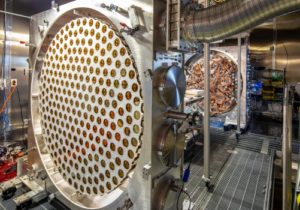July 23, 2019 — Most of the remaining components needed to fully assemble an underground dark matter-search experiment called LUX-ZEPLIN (LZ) arrived at the project’s South Dakota home during a rush of deliveries in June.

When complete, LZ will be the largest, most sensitive U.S.-based experiment yet that is designed to directly detect dark matter particles. Scientists around the world have been trying for decades to solve the mystery of dark matter, which makes up about 85 percent of all matter in the universe though we have so far only detected it indirectly through observed gravitational effects.
The bulk of the digital components for LZ’s electronics system, which is designed to transmit and record signals from ever-slight particle interactions in LZ’s core detector vessel, were among the new arrivals at the Sanford Underground Research Facility (SURF). SURF, the site of a former gold mine now dedicated to a broad spectrum of scientific research, was also home to a predecessor search experiment called LUX. A final set of snugly fitting acrylic vessels, which will be filled with a special liquid designed to identify false dark matter signals in LZ’s inner detector, also arrived at SURF in June. Also, the last two of four intricately woven wire grids that are essential to maintain a constant electric field and extract signals from the experiment’s inner detector, also called the time projection chamber, arrived in June (see related article).
“LZ achieved major milestones in June. It was the busiest single month for delivering things to SURF — it was the peak,” said LZ Project Director Murdock Gilchriese of the Department of Energy’s Lawrence Berkeley National Laboratory (Berkeley Lab). Berkeley Lab is the lead institution for the LZ project, which is supported by an international collaboration that has about 37 participating institutions and about 250 researchers and technical support crew members.
LZ is particularly focused on finding a type of theoretical particle called a weakly interacting massive particle or WIMP by triggering a unique sequence of light and electrical signals in a tank filled with 10 metric tons of highly purified liquid xenon, which is among Earth’s rarest elements. The properties of xenon atoms allow them to produce light in certain particle interactions. Proof of dark matter particles would fundamentally change our understanding of the makeup of the universe, as our current Standard Model of Physics does not account for their existence.
Assembly of the liquid xenon time projection chamber for LZ is now about 80 percent complete, Gilchriese said. When fully assembled later this month this inner detector will contain about 500 photomultiplier tubes. The tubes are designed to amplify and transmit signals produced within the chamber.
Project crews will soon begin testing the xenon circulation system, already installed underground, that will continually circulate xenon through the inner detector, further purify it, and reliquify it. Fiorucci said researchers will use about 250 pounds of xenon for these early tests. Work is also nearing completion on LZ’s cryogenic cooling system that is required to convert xenon gas to its liquid form.
LZ digital electronics, which will ultimately connect to the arrays of photomultiplier tubes and enable the readout of signals from particle interactions, were designed, developed, delivered, and installed by University of Rochester researchers and technical staff at SURF in June.
Also in June, LZ participants exercised high-speed data connections from the site of the experiment to the surface level at SURF and then to Berkeley Lab. Data captured by the detectors’ electronics will ultimately be transferred to LZ’s primary data center, the National Energy Research Scientific Computing Center (NERSC) at Berkeley Lab via the Energy Sciences Network (ESnet), a high-speed nationwide data network based at Berkeley Lab. NERSC and ESnet are DOE Office of Science User Facilities.
Major support for LZ comes from the DOE Office of Science, the South Dakota Science and Technology Authority, the U.K.’s Science & Technology Facilities Council, and by collaboration members in the U.S., U.K., South Korea, and Portugal.
About NERSC and Berkeley Lab
The National Energy Research Scientific Computing Center (NERSC) is a U.S. Department of Energy Office of Science User Facility that serves as the primary high-performance computing center for scientific research sponsored by the Office of Science. Located at Lawrence Berkeley National Laboratory, the NERSC Center serves more than 7,000 scientists at national laboratories and universities researching a wide range of problems in combustion, climate modeling, fusion energy, materials science, physics, chemistry, computational biology, and other disciplines. Berkeley Lab is a DOE national laboratory located in Berkeley, California. It conducts unclassified scientific research and is managed by the University of California for the U.S. DOE Office of Science. »Learn more about computing sciences at Berkeley Lab.
Source: NERSC and Berkeley Lab



























































